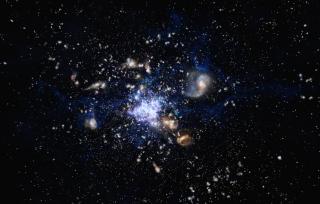Bibcode
Brisbin, Drew; Aravena, Manuel; Daddi, Emanuele; Dannerbauer, Helmut; Decarli, Roberto; González-López, Jorge; Riechers, Dominik; Wagg, Jeff
Referencia bibliográfica
Astronomy and Astrophysics, Volume 628, id.A104, 8 pp.
Fecha de publicación:
8
2019
Revista
Número de citas
19
Número de citas referidas
18
Descripción
We used the Plateau De Bure Interferometer to observe multiple CO and
neutral carbon transitions in a z = 2.2 main sequence disk galaxy,
BX610. Our observation of CO(7-6), CO(4-3), and both far-infrared (FIR)
[CI] lines complements previous observations of Hα and low-J CO,
and reveals a galaxy that is vigorously forming stars with UV fields
(Log(GG0-1) ≲ 3.25); although less vigorously
than local ultra-luminous infrared galaxies or most starbursting
submillimeter galaxies in the early universe. Our observations allow new
independent estimates of the cold gas mass which indicate
Mgas ˜ 2 × 1011 M⊙, and
suggest a modestly larger αCO value of ˜8.2. The
corresponding gas depletion timescale is ˜1.5 Gyr. In addition to
gas of modest density (Log(n cm3) ≲ 3) heated by star
formation, BX610 shows evidence for a significant second gas component
responsible for the strong high-J CO emission. This second component
might either be a high-density molecular gas component heated by star
formation in a typical photodissociation region, or could be molecular
gas excited by low-velocity C shocks. The CO(7-6)-to-FIR luminosity
ratio we observe is significantly higher than typical star-forming
galaxies and suggests that CO(7-6) is not a reliable star-formation
tracer in this galaxy.
The reduced spectra are only available at the CDS via anonymous ftp to
http://cdsarc.u-strasbg.fr
(ftp://130.79.128.5) or via http://cdsarc.u-strasbg.fr/viz-bin/qcat?J/A+A/628/A104
Proyectos relacionados

Gas Molecular y Polvo en Galacias através del Tiempo Cósmico
Dos cuestiones fundamentales en la Astrofísica son la conversión de gas molecuar en estrellas y cómo este proceso físico depende del entorno en todas las escalas, desde sistemas planetarios, cúmulos estelares, galaxias hasta cúmulos de galaxias. El objectivo principal de este proyecto es el de estudiar la formación y evolución de galaxias a partir
Helmut
Dannerbauer